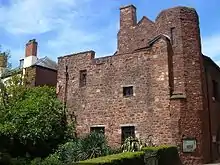Exeter monastery
Various monasteries and other religious houses have existed at various times during the Middle Ages in the city of Exeter, Devon, England.[1]

The monastic buildings included:
- Anglo-Saxon foundations
- Exeter Cathedral Priory, possibly founded before circa 690
- The Saxon Monastery, founded by King Æthelred of Wessex in 868
- The Benedictine Monastery, founded in 932 by King Æthelstan[2] and dedicated to Saint Mary and Saint Peter[3]
- The Nunnery of Saint Augustine, a nunnery of Augustinian Canonesses founded circa 968[4]
- Norman and later foundations
- The Benedictine Priory of St Nicholas, a Benedictine monastery founded in 1087[5]
- St James Priory, a Cluniac priory founded in 1146[6]
- Polsloe Priory, a Benedictine priory for women (a nunnery) founded circa 1159[7]
- Exeter Blackfriars, a Dominican friary founded before 1232[8]
- Exeter Grey Friary, a Franciscan friary founded before 1240[9]
- Exeter Priory, a Carthusian priory licensed in 1331–2 but never established
History
The origins of monasticism in Exeter are uncertain. Christianity arrived in Britain when Exeter was still a Roman city, and Celtic Christianity was introduced to the area during the 5th century by Welsh, Irish and Breton missionaries. Exeter was part of the Romano-British kingdom of Dumnonia during the Post-Roman period, and the Saxons did not reach the city until King Centwine of Wessex defeated the British in 682.[10] The Saxons gave the name Monkton to Exeter as a consequence of the large number of monks that it contained.[11] According to Willibald, an Anglo-Saxon priest who wrote a "Life" of Saint Boniface, the saint was educated at a monastery in 690 in a place variously called Adestancester, Escancastre, or Examchester,[12] names that have been identified with Exeter.[11] Exeter was sacked by the Danes in 1003, but the Benedictine monastery was restored by Cnut in 1019.
Bishop Leofric was appointed as Bishop of Cornwall and Bishop of Crediton in 1046. In 1050 he merged the two bishoprics to create the united see of Devon and Cornwall and moved the episcopal see to Exeter.[12][13] The new combined see incorporated Exeter's three monastic buildings of the time, all of which were located in Saint Peter's Close. The nunnery of Saint Augustine, the Saxon monastery and the Benedictine monastery were united to form the Cathedral Church.[1] The monastery was suppressed and converted into a secular cathedral.[14]
During the subsequent two centuries a number of priories and friaries were founded. These were all dissolved with the Dissolution of the Monasteries under Henry VIII and little remains. There is one building surviving from Polsloe Priory: the main part of the west range, built of the local red sandstone and believed to date from around 1320.[15] Nothing is extant from St James Priory except a cob wall surrounding the building currently on the site, which may be the precinct wall of the priory.[6] Parts of the Benedictine Priory of St Nicholas survive. The guest wing and a kitchen at its northern end were converted into an Elizabethan town house after dissolution, and this is now maintained as St Nicholas' Priory museum by Exeter City Council.[5] The refectory was used as a Georgian town house and is now owned by the Exeter Historic Buildings Trust.[16]
See also
References
- R. Trewman (1765). The Antient History and Description of the City of Exeter. p. 226.
- "Detailed Result: MONUMENT NO. 448317". Pastscape. Retrieved 22 September 2010.
- Richard John King (1861). Winchester. Salisbury. Exeter. Wells. pt. 2. Chichester. Canterbury. Rochester. John Murray. p. 185.
- "The Deanery". Historic England. Retrieved 8 September 2016.
- "Britannia Monasteries: St. Nicholas Priory, Exeter". Britannia.com. Archived from the original on 26 March 2016. Retrieved 22 September 2010.
- "St James Priory". Historic England. Retrieved 8 September 2016.
- "Polsloe Priory". Historic England. Retrieved 8 September 2016.
- "Exeter Blackfriars". Historic England. Retrieved 8 September 2016.
- "Exeter Greyfriars". Historic England. Retrieved 8 September 2016.
- "Sources for Anglo-Saxon Devon: Factsheet 28" (PDF). Devon County Council. Archived from the original (PDF) on 2 February 2017. Retrieved 8 September 2016.
- A Description of England and Wales: Containing a particular account of each county. London: printed for Newbery and Carnan. 1769. p. 141.
Adestancester.
- Paul Dalton; Dr. Charles Insley; Louise J. Wilkinson (2011). Cathedrals, Communities and Conflict in the Anglo-Norman World. Boydell Press. pp. 43–44. ISBN 9781843836209.
- "Britannia Biographies: Leofric, Bishop of Exeter". Britannia.com. Archived from the original on 11 October 2007. Retrieved 22 September 2010.
- David Knowles; C. N. L. Brooke; Vera C. M. London (2001). The Heads of Religious Houses: England and Wales, 940–1216. Cambridge University Press. p. 48. ISBN 9781139430746.
- Cornforth, David. "Polsloe Priory". Exeter Memories. Retrieved 8 September 2016.
- "St Nicholas' Priory - one of Exeter's gems". Exeter Memories. 26 July 2012. Retrieved 26 September 2016.
Further reading
- Nicholas Orme The Churches of Medieval Exeter. Exeter: Impress Books, 2014
